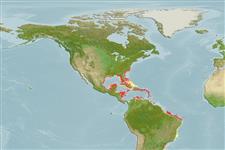Demospongiae |
Poecilosclerida |
Hymedesmiidae
Environment: milieu / climate zone / djupintervall / distribution range
Ekologi
Revassocierade; brackvatten; djupintervall 1 - 36 m (Ref. 108813). Tropical
Western Central Atlantic: Belize, Cuba and USA.
Length at first maturity / Size / Weight / Age
Könsmognad: Lm ? range ? - ? cm
Encrusting, 0.5 to 3 cm thick. Smooth surface with diagnostic pattern of round, slightly elevated pore fields not greater than 0.5 cm wide. Exterior and interior dark red to red-brown. Fragile and soft. Dark exudate when damaged. Elevated round oscules distributed irregulary with thin transparent or colored marginal membrane. Abundant spicules support the rounded warts at the surface (Ref. 85482).
Common on reefs; encrusts dead corals or the bases of live corals or on metamorphic rocks (Ref. 85482).
Life cycle and mating behavior
Könsmognad | Reproduktion | Lek | Eggs | Fecundity | Larvae
Members of the class Demospongiae are hermaphroditic. Life cycle: The zygote develops into parenchymella larva (free-swimming) before settling down on a substrate where it grows into a young sponge.
Engel, S. and J.R. Pawlik 2005 Interactions among Florida sponges. I. Reef habitats. Mar. Ecol. Prog. Ser. 303:133-144. (Ref. 837)
IUCN Red List Status
(Ref. 130435: Version 2025-1)
CITES status (Ref. 108899)
Not Evaluated
Not Evaluated
Threat to humans
Human uses
| FishSource |
Verktyg
Ytterligare information
Trophic EcologyFood items (preys)
Födosammansättning
Födointag
Predatorer
Population dynamicsTillväxt
Max. ages / sizes
Length-weight rel.
Length-length rel.
Length-frequencies
Mass conversion
Abundans
PhysiologySyreförbrukning
Human RelatedStamps, coins, misc.
Internet-källor
Estimates based on models
Preferred temperature
(Ref.
115969): 23.5 - 28.1, mean 27 (based on 642 cells).
Price category
Unknown.
